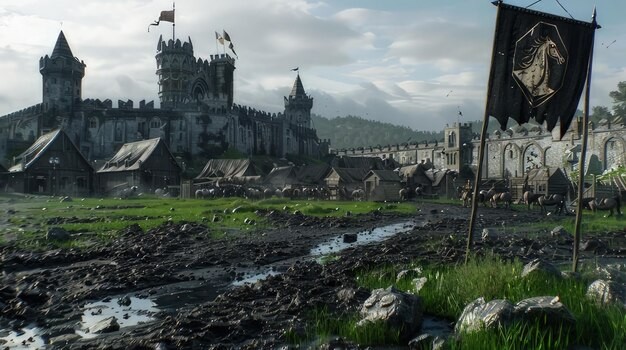Top Scottish Heritage Sites to Visit: A Journey Through Scotland’s Rich History
Scotland is a land steeped in history, with a heritage that spans centuries and includes everything from ancient castles to battlefields and stately homes. For anyone interested in exploring the rich cultural tapestry of this remarkable country, visiting Scottish heritage sites offers a unique opportunity to delve into its storied past. This article highlights some of the top Scottish heritage sites to visit, each providing a fascinating glimpse into Scotland’s historical and cultural legacy.
1. Edinburgh Castle
Dominating the skyline of Scotland's capital, Edinburgh Castle is a must-visit for anyone interested in Scottish history. Perched atop Castle Rock, this iconic fortress has been a royal residence, a military stronghold, and a symbol of Scotland's enduring spirit.
Historical Significance: Edinburgh Castle has played a central role in many pivotal events, including the Wars of Scottish Independence. It is also the birthplace of James VI, whose reign marked the union of Scotland and England.
Key Attractions: The Crown Jewels of Scotland and the Stone of Destiny are housed within the castle, adding to its historical significance. Visitors can explore the medieval Great Hall, the Crown Room, and the iconic St. Margaret's Chapel.
2. Stirling Castle
Stirling Castle, one of Scotland’s largest and most historically significant castles, is located in the town of Stirling. Its strategic location made it a key site in Scotland's history.
Historical Significance: Stirling Castle was the residence of many Scottish monarchs, including Mary, Queen of Scots. It was also the site of the Battle of Stirling Bridge in 1297, where William Wallace achieved a significant victory.
Key Attractions: The castle’s Renaissance Palace, the Great Hall, and the Tapestry Room are highlighted. The castle’s extensive history and beautiful views make it a fascinating site for history enthusiasts.
3. The Royal Mile
The Royal Mile is a historic street in Edinburgh that stretches from Edinburgh Castle to the Palace of Holyroodhouse. It is lined with historic buildings, museums, and traditional Scottish shops.
Historical Significance: The Royal Mile has been at the heart of Edinburgh’s history for centuries. It is the main thoroughfare of Edinburgh’s Old Town and has been the centre of Scottish life and politics since medieval times.
Key Attractions: Along the Royal Mile, visitors can explore St Giles' Cathedral, the Scotch Whisky Experience, and various historic closes and alleys. The mile is also home to several traditional Scottish pubs and eateries.
4. Culloden Battlefield
The Culloden Battlefield, located near Inverness, is one of Scotland's most significant historical sites. It was the site of the Battle of Culloden in 1746, which marked the end of the Jacobite uprising.
Historical Significance: The battle was a turning point in Scottish history, leading to the end of the Jacobite attempt to restore the Stuart monarchy. The site is preserved as a poignant reminder of this pivotal moment.
Key Attractions: The visitor centre offers a detailed exhibition of the battle, including interactive displays and personal stories from those who fought. The battlefield itself is marked with memorials and plaques.
5. The Palace of Holyroodhouse
The Palace of Holyroodhouse, located at the end of the Royal Mile in Edinburgh, is the official residence of the British monarch in Scotland. It has been a royal residence since the 16th century.
Historical Significance: The palace has been home to many Scottish and British monarchs, including Mary, Queen of Scots. It has witnessed numerous historical events and royal ceremonies.
Key Attractions: Visitors can explore the State Apartments, the Historic Apartments of Mary, Queen of Scots, and the beautiful palace gardens. The site also features an impressive collection of art and historical artifacts.
6. The Falkirk Wheel
The Falkirk Wheel is a modern engineering marvel and a unique heritage site. It is the world’s only rotating boat lift, connecting the Forth and Clyde Canal with the Union Canal.
Historical Significance: The Wheel represents Scotland’s commitment to integrating historical canal routes with modern engineering solutions. It symbolizes the country’s innovative spirit and its rich industrial heritage.
Key Attractions: Visitors can take a boat trip on the canals, watch the Wheel in action, and explore the on-site visitor centre, which offers exhibits on the history of the canals and the engineering behind the Wheel.
7. The National Museum of Scotland
Located in Edinburgh, the National Museum of Scotland is one of the country’s most important cultural institutions. It houses a vast collection of artefacts that span Scotland’s history and beyond.
Historical Significance: The museum’s exhibits cover everything from prehistoric Scotland to the modern era, offering insights into the country’s diverse cultural and historical heritage.
Key Attractions: Highlights include the Lewis Chessmen, an impressive collection of Scottish artefacts, and the museum’s extensive natural history exhibits. The museum also features interactive displays and educational programs.
8. The Kelpies
The Kelpies, located in Falkirk, are colossal horse-head sculptures that stand as a tribute to Scotland’s equine heritage and industrial past.
Historical Significance: The Kelpies represent the role of horses in Scotland’s history, particularly in the context of the country’s industrial heritage and its role in the development of the canal system.
Key Attractions: Visitors can take guided tours of the Kelpies, explore the surrounding Helix Park, and learn about the sculptures' design and construction. The site offers striking views and photo opportunities.
9. Bannockburn Visitor Centre
The Bannockburn Visitor Centre, located near Stirling, is dedicated to the Battle of Bannockburn, a crucial conflict in Scottish history.
Historical Significance: The Battle of Bannockburn in 1314 was a decisive victory for Robert the Bruce and the Scottish forces over the English. It was a pivotal moment in Scotland’s struggle for independence.
Key Attractions: The centre features interactive exhibits, a 3D battle simulation, and guided tours of the battlefield. The site provides a detailed and immersive experience of the battle and its significance.
10. The Brochs of Scotland
The brochs, ancient stone towers scattered across northern Scotland, are fascinating relics of Scotland’s Iron Age. Examples include:
Brodgar: Located on Orkney, this site features well-preserved brochs and provides insights into early Scottish society.
Burghead: The Broch of Burghead is a significant site on the Moray Coast, offering insights into the architectural and social aspects of brochs.
Getting There: Taxi Glasgow
For those starting their exploration from Glasgow, a taxi can provide a convenient and comfortable means of reaching many of these heritage sites. With a taxi Glasgow, visitors can easily navigate the scenic routes and enjoy a stress-free journey to Scotland’s historical treasures.
Conclusion
Scotland’s heritage sites offer a rich tapestry of historical and cultural experiences. From the imposing castles of Edinburgh and Stirling to the modern marvel of the Falkirk Wheel, each site provides a unique window into Scotland’s past. Exploring these sites allows visitors to connect with Scotland’s storied history, appreciate its architectural wonders, and gain a deeper understanding of its cultural legacy. Whether you’re captivated by medieval battles, royal residences, or ancient ruins, Scotland’s heritage sites promise an enriching journey through the nation’s past.




